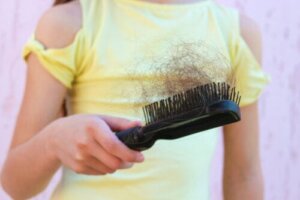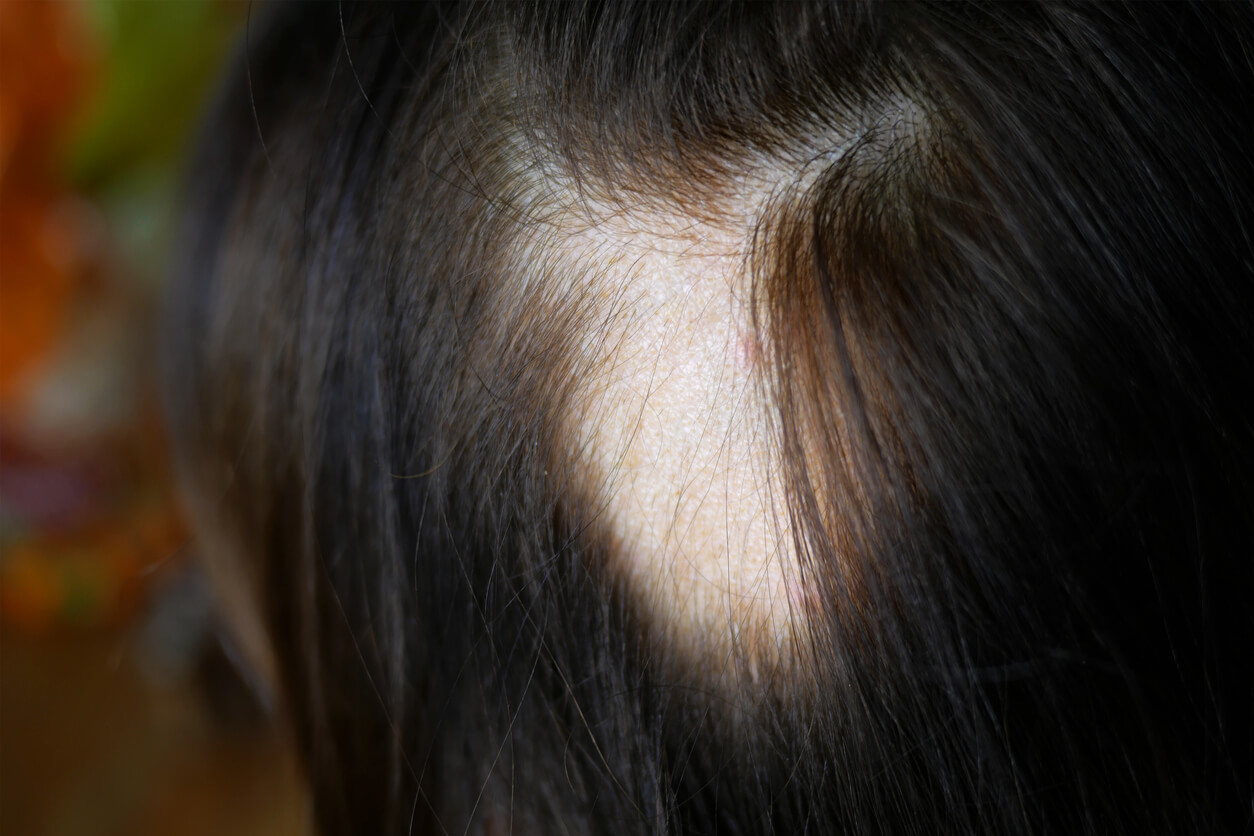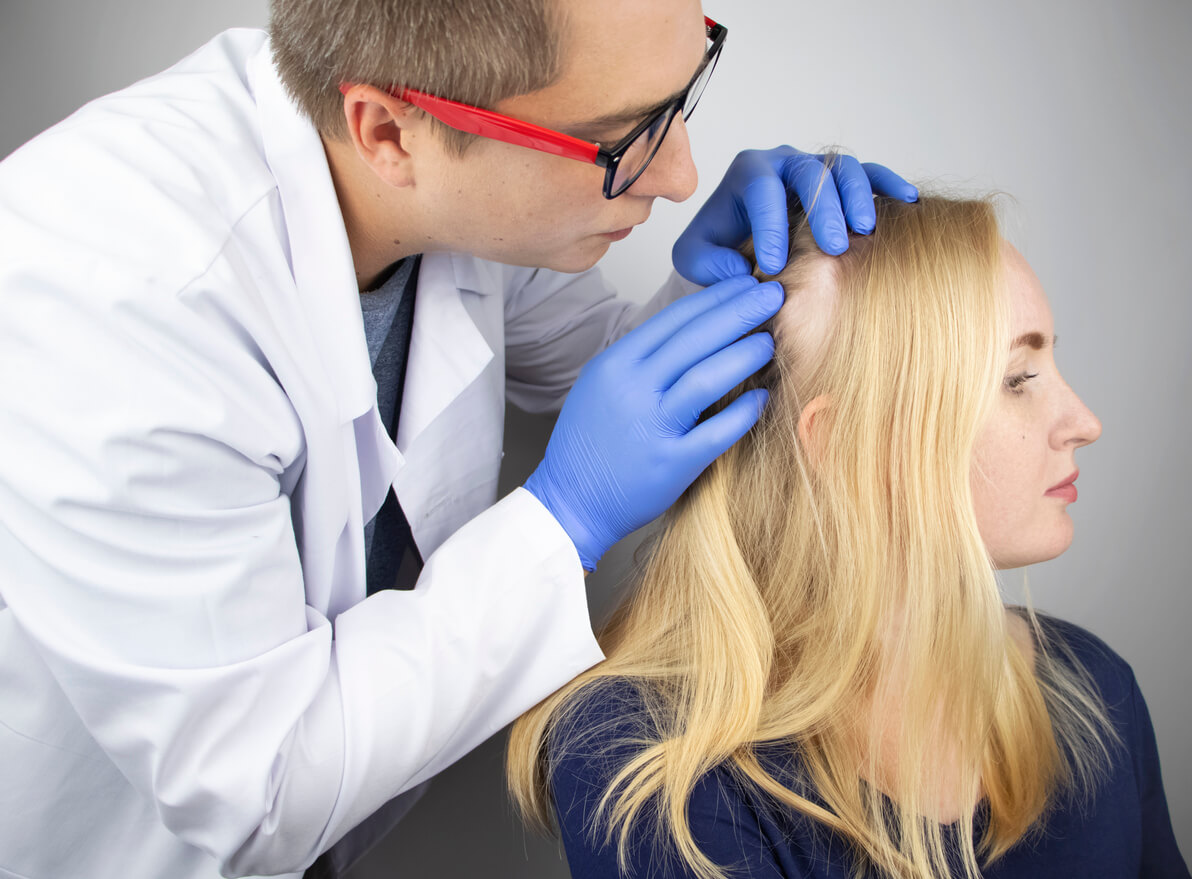Hair Loss in Adolescence: Symptoms, Causes, and Treatment

Hair loss is usually experienced in adolescence quite frequently. However, most people start to notice it during adulthood, and that has a big impact on self-esteem. In the following article, we’ll tell you the probable causes of this hair loss in adolescence and how to deal with it. Are you interested? Keep reading!
Causes of hair loss in adolescence
There are multiple causes of teenage hair loss, including hormonal imbalances, genetic factors, and certain underlying medical conditions.
On some occasions, this condition can be reversed with the correct treatment, so it’s worth knowing what causes it.
1. Genetic factors
Male or female pattern baldness is a genetic form of hair loss that occurs in a predictable way and is known as androgenic alopecia.
The male pattern usually begins with a recession of the hairline in the shape of a U, V, or M and a gradual loss of hair at the crown. In contrast, the female pattern is characterized by a gradual thinning throughout the entire head of hair.
In general, this type of hair loss begins in adulthood, but it can also be seen in adolescence. Therefore, it’s not uncommon for young people to experience this pattern of alopecia, especially if there’s a similar history in the family.

2. Alopecia areata
Alopecia areata is an autoimmune condition characterized by patchy hair loss, caused by a specific attack of the defense system on the hair follicles themselves. In addition to the scalp, this condition can manifest itself in any region of the body that has hair, such as the eyebrows, the body, or the eyelashes.
According to a Nature Reviews Disease Primers publication, this disease affects 2% of people at some point in their lives. In fact, a high percentage of these manifest it before the age of 30 and even in childhood.
3. Bad eating habits
Dietary imbalances or diets deficient in essential nutrients can cause hair loss. Among the most frequently involved elements are the following:
- Vitamin A, E, and C
- Zinc
- Biotin
- Vitamin E and D
- Niacin
- Folic acid
- Selenium
4. Thyroid diseases
Diseases of the thyroid gland can cause hair loss in adolescence or be responsible for the development of weak and brittle hair.
However, hair loss is more frequent in prolonged or severe thyroid disease and tends to recover with the correct treatment.
5. Polycystic Ovary Syndrome (PCOS)
This syndrome presents increased levels of male sex hormones (such as androgens) that produce certain imbalances in the body, such as the interruption of menstrual cycles, hair thinning, and acne.
The correct treatment of this condition can contribute to regenerating hair with normal properties.
How to recognize hair loss in adolescence?
Puberty produces fluctuations in the levels of some hormones that, as we’ve seen, are capable of altering hair growth. Hair loss can begin immediately after puberty and increase over time.
In general, during adolescence, there’s a loss of hair in patches, in a pattern, and a weakening and thinning of the hair fiber. Additionally, on those occasions where hair loss is caused by an underlying medical condition, you’re likely to experience other associated symptoms.
An early diagnosis by specialized medical personnel can improve the health of the hair and encourage its growth and regeneration.

Treatment of hair loss in adolescence
A doctor can diagnose the cause of the hair loss with a physical exam, a blood test, the personal history of the adolescent, and, if necessary, with a small biopsy of the scalp.
The treatment to be instituted will depend on the cause that leads to hair loss. Here are some examples:
- Alopecia areata: Local corticosteroid injections and topical ointments can help reverse the condition. Immunomodulatory drugs are also quite useful for this purpose.
- Genetic causes: The use of minoxidil and spironolactone is generally indicated, as well as finasteride and platelet-rich plasma (PRP).
- Poor diet: Correcting eating habits and vitamin and mineral deficiencies is key.
- Polycystic ovary syndrome: Doctors usually resort to the use of oral contraceptives, spironolactone, or metformin.
- Thyroid disease: In this case, medication is indicated to balance hormone levels.
There are other causes of hair loss, such as the consumption of certain medications, systemic lupus erythematosus, scalp ringworm, or telogen effluvium. For this reason, it must be known that, on some occasions, the treatment doesn’t completely reverse the clinical picture.
Hair loss and self-esteem
The objective of stopping hair loss is to reduce the discomfort, anxiety, or anguish that this produces And, at the same time, it’s important to take this sign into account as an indication of some hidden disease that should be studied.
Hair loss can cause low self-esteem and negatively impact a teen’s confidence. And in turn, it can be the consequence of situations of stress or anxiety at any age.
Hair loss is usually experienced in adolescence quite frequently. However, most people start to notice it during adulthood, and that has a big impact on self-esteem. In the following article, we’ll tell you the probable causes of this hair loss in adolescence and how to deal with it. Are you interested? Keep reading!
Causes of hair loss in adolescence
There are multiple causes of teenage hair loss, including hormonal imbalances, genetic factors, and certain underlying medical conditions.
On some occasions, this condition can be reversed with the correct treatment, so it’s worth knowing what causes it.
1. Genetic factors
Male or female pattern baldness is a genetic form of hair loss that occurs in a predictable way and is known as androgenic alopecia.
The male pattern usually begins with a recession of the hairline in the shape of a U, V, or M and a gradual loss of hair at the crown. In contrast, the female pattern is characterized by a gradual thinning throughout the entire head of hair.
In general, this type of hair loss begins in adulthood, but it can also be seen in adolescence. Therefore, it’s not uncommon for young people to experience this pattern of alopecia, especially if there’s a similar history in the family.

2. Alopecia areata
Alopecia areata is an autoimmune condition characterized by patchy hair loss, caused by a specific attack of the defense system on the hair follicles themselves. In addition to the scalp, this condition can manifest itself in any region of the body that has hair, such as the eyebrows, the body, or the eyelashes.
According to a Nature Reviews Disease Primers publication, this disease affects 2% of people at some point in their lives. In fact, a high percentage of these manifest it before the age of 30 and even in childhood.
3. Bad eating habits
Dietary imbalances or diets deficient in essential nutrients can cause hair loss. Among the most frequently involved elements are the following:
- Vitamin A, E, and C
- Zinc
- Biotin
- Vitamin E and D
- Niacin
- Folic acid
- Selenium
4. Thyroid diseases
Diseases of the thyroid gland can cause hair loss in adolescence or be responsible for the development of weak and brittle hair.
However, hair loss is more frequent in prolonged or severe thyroid disease and tends to recover with the correct treatment.
5. Polycystic Ovary Syndrome (PCOS)
This syndrome presents increased levels of male sex hormones (such as androgens) that produce certain imbalances in the body, such as the interruption of menstrual cycles, hair thinning, and acne.
The correct treatment of this condition can contribute to regenerating hair with normal properties.
How to recognize hair loss in adolescence?
Puberty produces fluctuations in the levels of some hormones that, as we’ve seen, are capable of altering hair growth. Hair loss can begin immediately after puberty and increase over time.
In general, during adolescence, there’s a loss of hair in patches, in a pattern, and a weakening and thinning of the hair fiber. Additionally, on those occasions where hair loss is caused by an underlying medical condition, you’re likely to experience other associated symptoms.
An early diagnosis by specialized medical personnel can improve the health of the hair and encourage its growth and regeneration.

Treatment of hair loss in adolescence
A doctor can diagnose the cause of the hair loss with a physical exam, a blood test, the personal history of the adolescent, and, if necessary, with a small biopsy of the scalp.
The treatment to be instituted will depend on the cause that leads to hair loss. Here are some examples:
- Alopecia areata: Local corticosteroid injections and topical ointments can help reverse the condition. Immunomodulatory drugs are also quite useful for this purpose.
- Genetic causes: The use of minoxidil and spironolactone is generally indicated, as well as finasteride and platelet-rich plasma (PRP).
- Poor diet: Correcting eating habits and vitamin and mineral deficiencies is key.
- Polycystic ovary syndrome: Doctors usually resort to the use of oral contraceptives, spironolactone, or metformin.
- Thyroid disease: In this case, medication is indicated to balance hormone levels.
There are other causes of hair loss, such as the consumption of certain medications, systemic lupus erythematosus, scalp ringworm, or telogen effluvium. For this reason, it must be known that, on some occasions, the treatment doesn’t completely reverse the clinical picture.
Hair loss and self-esteem
The objective of stopping hair loss is to reduce the discomfort, anxiety, or anguish that this produces And, at the same time, it’s important to take this sign into account as an indication of some hidden disease that should be studied.
Hair loss can cause low self-esteem and negatively impact a teen’s confidence. And in turn, it can be the consequence of situations of stress or anxiety at any age.
All cited sources were thoroughly reviewed by our team to ensure their quality, reliability, currency, and validity. The bibliography of this article was considered reliable and of academic or scientific accuracy.
- Pratt CH, King LE Jr, Messenger AG, Christiano AM, Sundberg JP. Alopecia areata. Nat Rev Dis Primers. 2017 Mar 16;3:17011. doi: 10.1038/nrdp.2017.11. PMID: 28300084; PMCID: PMC5573125.
- Hair loss types: Alopecia areata causes. [Internet] Disponible en: https://www.aad.org/public/diseases/hair-loss/types/alopecia/causes
- Diet and hair loss: effects of nutrient deficiency and supplement use. [Internet] Disponible en: https://dpcj.org/index.php/dpc/article/view/dermatol-pract-concept-articleid-dp0701a01
This text is provided for informational purposes only and does not replace consultation with a professional. If in doubt, consult your specialist.








